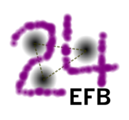The Wigner bound is examined at different non-perturbative pionless effective field theory ($\slashed{\pi}EFT$) orders. Using cutoff regulator we show that the Wigner bound loosens when going from the next-to-leading-order (NLO) to the next-to-next-to-leading-order (N$^2$LO), and up to N$^6$LO. We conjecture an analytic formula for the general dependence of the Wigner bound on the...
The accuracy of reconstructing a response function from its Lorentz integral transform is studied for an exactly solvable case. The model considered here is the dipole photodisintegration of the bound state of three particles interacting via a hypercentral potential. The inversion procedure is discussed in detail and its optimal version is presented. Unlike results in the literature pertaining...
An extrapolation of ab initio results to get more accurate observables became a trend in nuclear physics [1-4]. We consider calculations of binding energies in oscillator basis, which depend on two
basis parameters, the oscillator frequency, $\hbar\Omega$, and the oscillator quanta, $N$. We study general convergence patterns of these calculations. We use the SS-HORSE (single-state...
We utilize a baryonic effective field theory (EFT) to analyze recent Lattice QCD (LQCD) few-body calculations. To this end we have developed a finite volume few-body code based on the Stochastic Variational Method (SVM) including 2 and 3-body interactions. This new tool enable us to study the LQCD spectra directly without the need of infinite volume extrapolation. Furthermore, it can be used...

